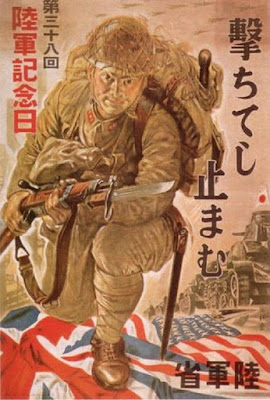
Weighing in at two pounds three ounces, this chrome-molybdenum steel helmet is lighter than many other combat helmets of the era. The model 30-32 served throughout the war and beyond, often found among the materiel of insurgent nationalist groups in Indonesia, Vietnam, and other European colonies occupied by the Japanese during the war.
Now for the walk around:
Two pairs of small holes in the dome provide some ventilation.
Viewed from above, the slightly ovoid shape of the shell is evident.
The three-leaved liner is similar to many European helmets of the era.
The insignia of the Imperial Japanese Army is made manifest by an iron, five-pointed star affixed to the front of the helmet.
Long fabric tapes comprise the chinstraps.
Some methods of fastening the chintstraps were bizarrely elaborate. The private was so busy fastening his helmet that he didn't notice the Marine with the satchel-charge sealing the mouth of the tunnel. Sometimes, attention to detail will bite you.
A nice design detail is the sewn point at the ends of the tapes.
The liner leaves are similar to the German m.16 of the Great War.
Also similar to many European helmets of the era, the liner leaves are backed by fabric envelopes into which batting or other material can be stuffed to provide padding as well as to adjust the fit.
A sturdy cord gathers the leaves of the liner together.
Two vertical peened rivets secure...
A staple and split ring which in turn...
secure the chinstrap keeper loop.
Two similar horizontal rivets...
affix a staple which secures...
split rings that the chinstrap passes through on the sides of the helmet, these are in the same position, and serve the same function, as the chinstrap bails on Western helmets.
Two robust split pins...
secure the leather liner band to the shell. A third point of securement are the prongs that affix the star insignia which pass through the liner band.
The liner band is joined at the front and rear with heavy stitching.
To ease production time as well as reduce cost the model 30-32 has a raw-edged rim.
And here are images of the model 30-32 in action:
See you next time with another cool helmet from the collection!
Mannie

































